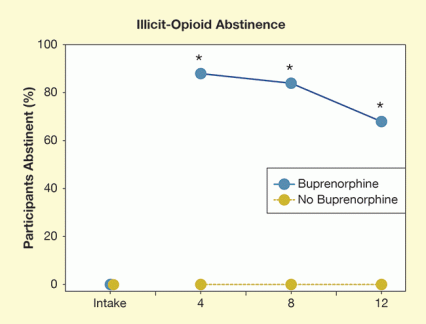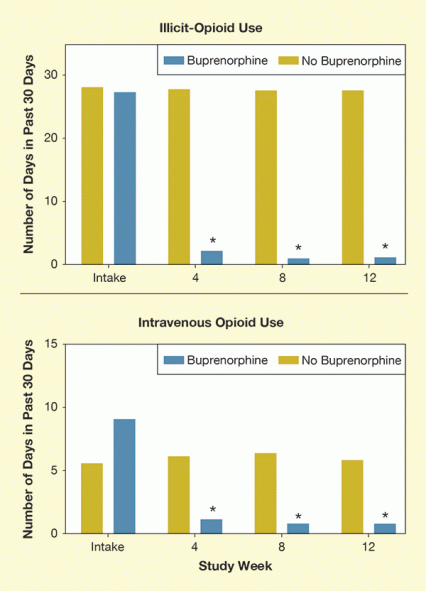- In two pilot clinical trials, buprenorphine helped participants reduce their illicit opioid use and injection drug use while awaiting admission to a methadone or buprenorphine treatment program.
- Researchers minimized the risks for improper use or diversion of the study medication by giving it to trial participants in a computerized, tamper-proof device that dispenses one dose each day.
- Research staff monitored participants’ craving, withdrawal, drug use, and medication adherence with an interactive voice response system and random callbacks.
For most adults with opioid use disorder, maintenance therapy with methadone or buprenorphine is the most effective treatment approach. However, many who present to clinics offering such treatment are placed on waitlists for months. During this time, they are at high risk for continued drug use, overdose, death, criminal activity, infectious diseases, and other negative outcomes. Although studies have shown that interim methadone treatment can reduce drug use and associated risks during the waitlist period, regulatory and logistical challenges have hindered its wide implementation. Now, NIDA-supported researchers have developed an interim buprenorphine regimen and found it to be safe, effective, and potentially feasible in two small trials.
 Figure 1. E-Pill Med-O-Wheel SECURE Device This locked, portable, automatic pill dispenser minimized the risks for improper use or diversion of the study medication.
Figure 1. E-Pill Med-O-Wheel SECURE Device This locked, portable, automatic pill dispenser minimized the risks for improper use or diversion of the study medication.Image used with permission from Addoz®
Dr. Stacey Sigmon and colleagues at the University of Vermont used technology to provide waitlisted opioid users with controlled access to buprenorphine and support their abstinence with minimal clinical and administrative input. After a week of daily clinic visits in which the trial participants were inducted onto buprenorphine and their dosing requirements determined, each was issued a Med-O-Wheel Secure dispensing device stocked with a 2-week supply of buprenorphine/naloxone sublingual tablets (see Figure 1). The tamper-proof device was programmed to make each day’s dose available during a 3-hour time window. Each evening, participants were contacted via a phone-based interactive voice response (IVR) system and prompted to rate their opioid cravings and withdrawal symptoms and to report any use of opioids or other drugs. Once every other week, at random times, the IVR system also notified participants to report to the clinic for urine drug testing and progress monitoring. Participants could also contact the research staff between visits if they experienced difficulties with craving, withdrawal, or other problems.
 Figure 2. Effects of Interim Buprenorphine on Abstinence From Illicit Opioids In the 12-week study, 50 participants were randomly assigned to buprenorphine or the control condition without buprenorphine. The data points show the proportion of patients who submitted illicit-opioid-free urine samples at intake and at 4-week intervals. Among the study participants randomly assigned to buprenorphine, 88 percent submitted illicit-opioid-free at week 4, 84 percent at week 8, and 68 percent at week 12. In contrast, none of the control participants submitted any illicit-opioid-free urine samples throughout the entire study.
Figure 2. Effects of Interim Buprenorphine on Abstinence From Illicit Opioids In the 12-week study, 50 participants were randomly assigned to buprenorphine or the control condition without buprenorphine. The data points show the proportion of patients who submitted illicit-opioid-free urine samples at intake and at 4-week intervals. Among the study participants randomly assigned to buprenorphine, 88 percent submitted illicit-opioid-free at week 4, 84 percent at week 8, and 68 percent at week 12. In contrast, none of the control participants submitted any illicit-opioid-free urine samples throughout the entire study.* p<0.001
- Text Description of Figure 2
-
The figure shows two graphs illustrating the effects of interim buprenorphine on abstinence from illicit-opioid use. The horizontal (x-) axis shows the time, with 4 timepoints marked: intake, 4, 8, and 12 weeks. The vertical (y-) axis shows the percentage of study participants who were abstinent—that is, submitted drug-free urine samples. The scale goes from 0 to 100. A blue curve reflects the results of patients receiving interim buprenorphine. At intake, none of these patients had an illicit-opioid–free urine sample. In contrast, 88 percent of these patients submitted a drug-free sample at 4 weeks, 84 percent at 8 weeks, and 68 percent at 12 weeks. A gold curve shows the corresponding results from control patients not receiving buprenorphine. At all four time points, none of these patients had a drug-free urine sample. Asterisks above the blue buprenorphine time points indicate that the difference between the buprenorphine-treated participants and the control participants was statistically significant with a P value <0.001.
Dr. Sigmon and colleagues first tested their approach in a feasibility trial with 10 participants who had been using opioids, on average, for 8.4 years. Most primarily used prescription opioids, although 60 percent reported having used heroin at least once. After being stabilized on buprenorphine, 90 percent of participants provided urine samples that were negative for illicit opioids at 2 and 4 weeks, and 60 percent were abstinent at 8, 10, and 12 weeks. Whereas the participants reported using opioids on 29 days, on average, in the month before starting the trial, the seven who completed the trial reported using the drugs an average of 0.35 days during its final month. The participants also registered lower scores on the Addiction Severity Index at the end of the study, compared with their scores at intake. Completion of the IVR calls and random callbacks were high at 97 and 82 percent, respectively.
 Figure 3. Effects of Interim Buprenorphine on Self-Reported Use of Illicit Opioids and Injection Opioids In the 12-week study, 50 participants were randomly assigned to buprenorphine or the control condition without buprenorphine. The bars represent the number of days on which participants in the two groups reported use of illicit opioids or intravenous opioids in the past 30 days at intake and at intervals of 4 weeks. After 4, 8, and 12 weeks, study participants taking buprenorphine reported significantly fewer days of illicit-opioid and intravenous opioid use compared with the control subjects.
Figure 3. Effects of Interim Buprenorphine on Self-Reported Use of Illicit Opioids and Injection Opioids In the 12-week study, 50 participants were randomly assigned to buprenorphine or the control condition without buprenorphine. The bars represent the number of days on which participants in the two groups reported use of illicit opioids or intravenous opioids in the past 30 days at intake and at intervals of 4 weeks. After 4, 8, and 12 weeks, study participants taking buprenorphine reported significantly fewer days of illicit-opioid and intravenous opioid use compared with the control subjects.* p<0.001
- Text Description of Figure 3
-
The figure shows two bar graphs illustrating the effects of interim buprenorphine on frequency of illicit-opioid use and intravenous opioid use. In both graphs, the horizontal (x-) axis shows the time, with 4 timepoints marked: intake, 4, 8, and 12 weeks. The vertical (y-) axis shows the number of days during the past 30 days that the participants reported using illicit opioids or intravenous opioids. In the upper panel for illicit-opioid use, the scale goes from 0 to 30; in the lower panel for intravenous opioid use it goes from 0 to 15. In both panels, participants treated with interim buprenorphine are represented by blue bars, whereas control patients are represented by gold bars.
In the upper panel for illicit opioid use, the bars for both patient groups at intake indicate illicit-opioid use on about 27 to 28 days. For the control group, the gold bars at 4, 8, and 12 weeks remain at that level, indicating illicit drug use on 27 to 28 days. For the buprenorphine-treated patients, the blue bars indicate illicit drug use on about 2 days in the last 30 days at 4 weeks and on about 1 day in the last 30 days at 8 and 12 weeks. Asterisks above these blue bars indicate that the difference between buprenorphine-treated and control patients is statistically significant with a P value <0.001.
In the lower panel for intravenous opioid use, the gold bars indicate that patients in the control group at intake reported use of intravenous opioids on about 5 days in the past 30 days and that this level of use remained constant at 5 to 6 days in the past 30 days throughout the study. For the buprenorphine-treated patients, the blue bars indicate intravenous drug use at intake on about 9 days in the last 30 days; this declined to about 1 day in the last 30 days at 4 weeks and to less than 1 day in the last 30 days at 8 and 12 weeks. Asterisks above these blue bars indicate that the difference between buprenorphine-treated and control patients is statistically significant with a P value <0.001.
In the subsequent larger trial, 25 waitlisted opioid-dependent adults were randomized to receive interim treatment with buprenorphine, and another 25 to remain in a waitlist control condition. Nearly 90 percent of the participants who received buprenorphine provided urine specimens that were free of illicit opioids at 4 and 8 weeks after induction, and nearly 70 percent at 12 weeks (see Figure 2). In contrast, no control participants provided illicit-opioid–negative specimens during the trial. The participants who received buprenorphine also reported significant reductions in frequency of illicit-opioid use and injection-opioid use, as well as in Addiction Severity Index scores (see Figure 3). Similar to the prior study, the patients who received buprenorphine responded to nearly all—96 percent—of both the IVR calls and the random callbacks.
Dr. Sigmon and colleagues will aim to replicate and extend these results in larger trials. Ultimately, they hope that their approach to helping treatment-seeking opioid users reduce risks while awaiting program admission will prove both beneficial and cost-effective.
These studies were supported by NIH grants DA037385, T32DA007242, and P20GM103644.
Sources
Sigmon, S.C., Meyer, A.C., Hruska, B., et al. Bridging waitlist delays with interim buprenorphine treatment: Initial feasibility. Addictive Behaviors 51:136-142, 2015. Full text
Sigmon, S.C., Ochalek, T.A., Meyer, A.C., et al. Interim buprenorphine vs. waiting list for opioid dependence. New England Journal of Medicine 375(25):2504-2505, 2016. Abstract